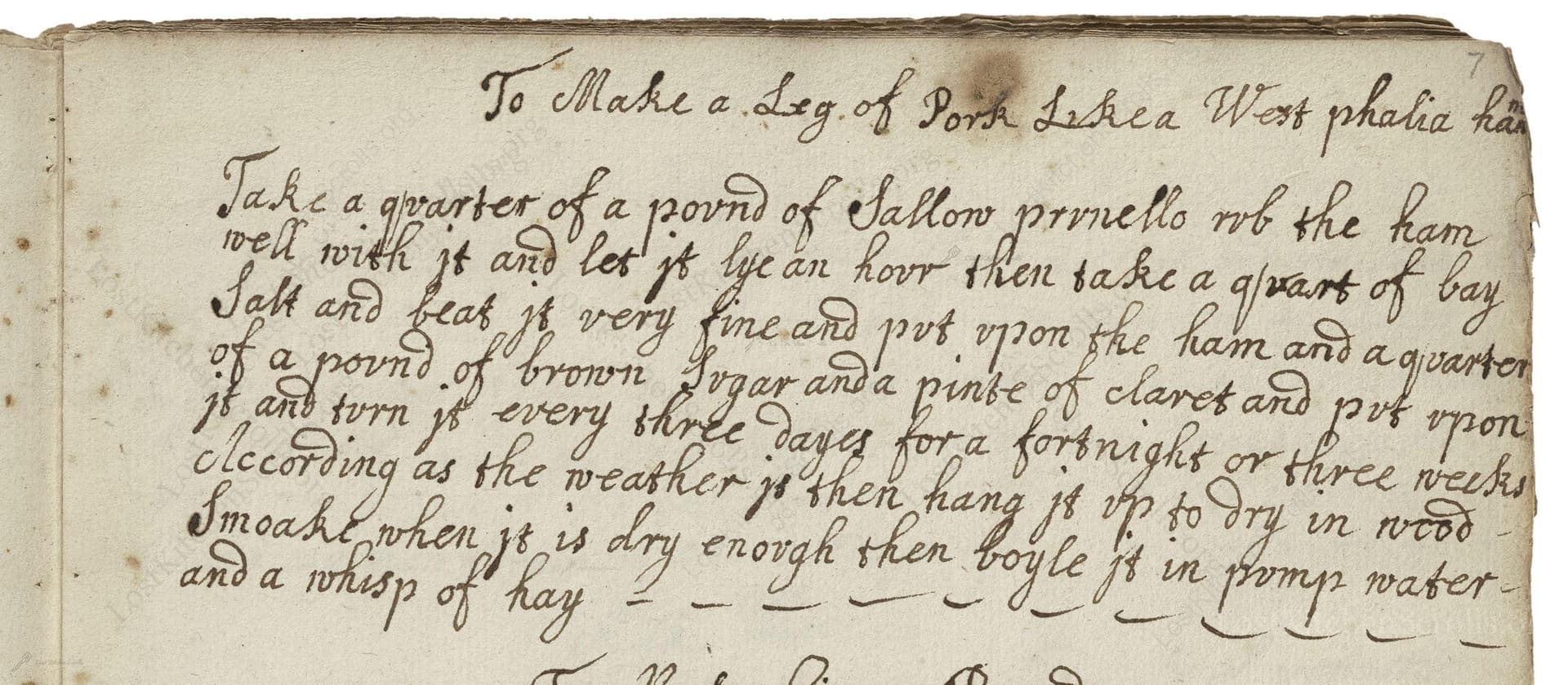To Make A Leg Of Pork Like A West Phalia Ham
From the treasured pages of Cookbook of Mary Cruso and Timothy Cruso
Written by Mary Cruso

To Make A Leg Of Pork Like A West Phalia Ham
"Take a quarter of a pound of Sallow prunello rub the ham well with it and let it lye an hour then take a quart of bay Salt and beat it very fine and put upon the ham and a quarter of a pound of brown Sugar and a pinte of claret and put upon it and turn it every three dayes for a fortnight or three weeks according as the weather is then hang it up to dry in wood smoake when it is dry enough then boyle it in pomp water and a whisp of hay"
Note on the Original Text
The original recipe uses phonetic spelling and period vocabulary—'pork' is called a 'leg of pork,' 'bay salt' refers to a coarse, mineral-rich salt, and 'prunello' means sloe plums or prunes. Quantities are given in pounds, quarts, and pints, which converts to metric for clarity. Directions are brief and assume a working knowledge of kitchen practices; instructions like 'let it lye' or 'turn it every three days' are typical, expecting readers to fill in procedural gaps from their own experience.

Title
Cookbook of Mary Cruso and Timothy Cruso (1689)
You can also click the book image above to peruse the original tome
Writer
Mary Cruso
Era
1689
Publisher
Unknown
Background
Step into the flavorful world of 17th-century cuisine with Mary Cruso’s delightful collection, where time-honored recipes and inventive cookery tips offer a peek at the tastes and talents of yesteryear’s domestic kitchens.
Kindly made available by
Folger Shakespeare Library
This recipe is attributed to Mary Cruso, dating to 1689, a period when English cooks were eager to replicate the savory flavors of continental Delicacies, such as the famed Westphalian hams from Germany. The preservation of pork through curing and smoking was a practical necessity before refrigeration, and these processes also conferred distinctive tastes highly prized at the time. The use of sloe or prunellos, along with exotic elements like claret, points to the growing cosmopolitan influences in late Stuart English kitchens.

In the late 17th century, cooks relied on large earthenware or wooden troughs for salting and curing meat. The turning process was done by hand, ensuring even distribution of the cure. Smoking would have taken place in a smokehouse or over a hearth using hardwood chips, and once cured, a large pot would be used to gently simmer the ham, often with straw or hay to prevent sticking and add a grassy note. Simple knives, ladles, and coarse cloths were essential for handling and cleaning.
Prep Time
30 mins
Cook Time
2 hrs 30 mins
Servings
10
We've done our best to adapt this historical recipe for modern kitchens, but some details may still need refinement. We warmly welcome feedback from fellow cooks and culinary historians — your insights support the entire community!
Ingredients
- 1 pork leg (4.5-5.5 lbs)
- 4 oz sloe (prunus spinosa) puree or 4 oz mashed dried plums (prunes) as substitute
- 4 1/4 cups bay salt (or 2 lbs kosher salt mixed with crushed bay leaves)
- 4 oz brown sugar
- 2 cups dry red wine (claret or a modern Bordeaux)
- Fresh hay (a small bunch, thoroughly washed)
- Plenty of water (for boiling at end stage)
Instructions
- Begin by thoroughly rubbing a pork leg (about 4.5-5.5 lbs) with 4 oz of sloe (blackthorn) puree or substitute with dried plums (prunes) mashed, allowing it to sit for one hour.
- Next, cover the leg completely with 4 1/4 cups of finely ground bay salt (or 2 lbs kosher salt mixed with crushed bay leaves as a substitute), 4 oz of brown sugar, and pour over 2 cups of dry red wine (claret).
- Place the pork in a non-reactive container and turn the meat every three days, ensuring the cure is evenly distributed, for 2-3 weeks depending on the ambient temperature (cooler conditions require longer curing).
- Once cured, hang the pork in a cool, well-ventilated area and expose it to wood smoke until thoroughly dry (approximately 7-14 days).
- To serve, simmer gently in ample water with a handful of clean hay until tender, then slice and enjoy.
Estimated Calories
450 per serving
Cooking Estimates
This recipe takes time because you need to cure the pork leg for a few weeks. Actual hands-on work is about 30 minutes, while cooking the pork in water with hay takes around 2.5 hours. Each serving has about 450 calories, and the pork leg feeds about 10 people.
As noted above, we have made our best effort to translate and adapt this historical recipe for modern kitchens, taking into account ingredients nowadays, cooking techniques, measurements, and so on. However, historical recipes often contain assumptions that require interpretation.
We'd love for anyone to help improve these adaptations. Community contributions are highly welcome. If you have suggestions, corrections, or cooking tips based on your experience with this recipe, please share them below.
Join the Discussion
Rate This Recipe
Dietary Preference
Main Ingredients
Occasions

Den Bockfisch In Einer Fleisch Suppen Zu Kochen
This recipe hails from a German manuscript cookbook compiled in 1696, a time whe...

Die Grieß Nudlen Zumachen
This recipe comes from a rather mysterious manuscript cookbook, penned anonymous...

Ein Boudain
This recipe comes from an anonymous German-language manuscript cookbook from 169...

Ein Gesaltzen Citroni
This recipe, dating from 1696, comes from an extensive anonymous German cookbook...
Browse our complete collection of time-honored recipes



